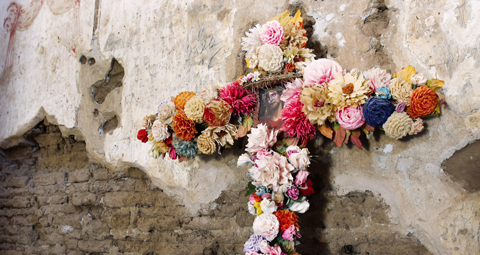August 17 | ![]() 0 COMMENTS
0 COMMENTS ![]() print
print

A horticultural revolution in our communities
Ross Ahlfeld looks at how gardening is being used to combat mental illness and social problems
One of the things I adore about the recent arrival of fine weather is seeing folks outdoors enjoying their gardens, busily digging and planting; most of all, I delight in catching glimpses of the last old corrugated iron ‘Anderson Shelters’ in peoples gardens, still being used as tool sheds. There is something quite biblical about these remnants of the war, now being used for the peaceful business of gardening. As scripture says, ‘and they shall beat their swords into plowshares, and their spears into pruning hooks’ (Isaiah 2:4).
Interestingly, Clement Attlee’s post-war Labour Government’s drive to allocate growing spaces to each of the new council houses built after 1945 is regarded by some as an effort to build a ‘New Jerusalem.’ Just as the 1941 Beveridge Report, which subsequently inspired the construction of decent social housing as to eliminate squalor and disease, also employed the familiar allegorical Christian language of John Bunyan’s Pilgrim’s Progress.
Amazingly, 700,000 homes were destroyed by bombs during the Second World War and almost one million new houses were built with 80 per cent of them being council houses. But this still wasn’t enough and so 157,000 were built as ‘prefabs,’ which I’m sure some older readers will still recall.
Yet, just as Admiral Nelson erroneously insisted on the planting of trees so that we could build more ships, so too did the 1945 Government insist on the provision of large growing spaces to get us through the rationing which was expected to follow on from the next war, which thankfully never came.
As such, these days more of us tend to grow flowers in our gardens rather than tatties and veg but what goes around comes around, things are changing again and down my way there is a quiet horticultural revolution taking place within our community. More and more grassroots community groups and organisations are now setting up growing spaces and community gardens as a way to reduce carbon and help mitigate the worst effects of austerity. Meanwhile, other projects are trying to offer freshly grown alternatives to the mostly dried and processed foodstuffs being distributed via food banks.
For example, the brilliant ‘Branching Out’ project based in Port Glasgow uses horticulture as a vehicle to offer a range of different training, work experience, supported employment, and recreational activities for a variety of individuals including adults and children with learning and/or physical disabilities and those with mental health problems.
As does the nearby Broomhill Gardens & Community Hub in Greenock which is run as a social enterprise by Inverclyde Association for Mental Health who provide landscaping, ground maintenance and horticulture to people in our area who have experienced mental health issues or have experienced long term unemployment.
Similarly, Belville Community Garden in Greenock is a community garden created on waste ground previously occupied by high flats. This thriving space is now used by local people and local schools to undertake different growing, biodiversity and environmental projects.
Meanwhile Inverclyde Community Development Trust have also set up a community garden and community kitchen in Port Glasgow right in the middle of an industrial estate and former factory space. Yet it’s not just vegetables being grown in Port Glasgow, friendships and fellowships are also being grown here too, as well as offering therapeutic training and employment opportunities for everyone in the community.
For us Catholics this is very much our business too, we too also recognise the moral and spiritual value of growing our own food and caring for our environment. Just as we also see the value of holistic, person-centred approaches towards poverty which honour the dignity and rights of each person.
We know this because all of these ideas are contained within Pope Francis’s magnificent 2015 encyclical Laudato Si’ which covers topics such as environmentalism, urban planning, agricultural economics and biodiversity.
However, it didn’t begin with Laudato Si: in 1926 the famous Dominican Fr Vincent McNabb began to advocate for a Catholic ‘Back-to-the-Land’ movement in his book, The Church and the Land. McNabb went so far as to say that the city had become the graveyard of religion and the machine age is the doom of mankind.
Similarly, Dorothy Day established several Catholic Worker Farms, many of which still exist today. Dorothy asks us, ‘How can we teach our children about creation and creator when there are only man-made streets about? How can we teach them about life and death and resurrection unless they see the seed fall into the ground and die and yet bring forth fruit?’
Dorothy Day’s friend, contemporary and fellow ‘Servant of God’ Catherine Doherty, the foundress of Madonna House Apostolate, took this idea even further by stating that ‘there are in the world two people who really touch God: the priest touches God in his very essence; the farmer touches God in his creation as it came from his hands.”
These are very powerful words which should challenge any so-called ‘traditionalists’ foolish enough to dismiss ‘Christian environmentalism’ as being a wee bit ‘hippy dippy’ or modernist.
Perhaps the last word should go to the great Peter Maurin who looked back to medieval times and seen our Liturgy and ecology is wholly Sacramental and intrinsically interconnect. “The people who built the Cathedral of Chartres,” he said, “knew how to combine cult—that is to say Liturgy—with culture—that is to say philosophy—and cultivation—that is to say agriculture.”











